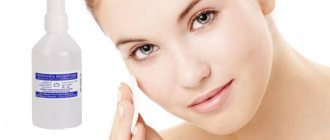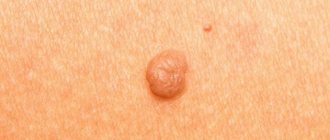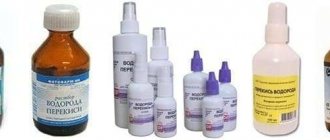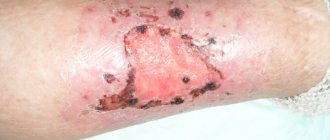A burn from hydrogen peroxide is considered a chemical burn. It is obtained due to improper use for household, medical and cosmetic purposes. Often such injuries occur due to non-compliance with recommendations and rules of therapy. For example, if the concentration of the drug specified in the prescription is exceeded, skin burns are inevitable.
When using peroxide internally for health purposes to treat somatic diseases, a high concentration of H2O2 is especially dangerous. In this case, internal burns of the oral mucosa and gastrointestinal tract are possible, which is fraught with serious consequences.
Causes of hydrogen peroxide burns
Peroxide burns are most often caused by careless handling of the chemical reagent.
- Burns to the throat with hydrogen peroxide, as well as to the gastrointestinal tract (oral cavity, rectum, stomach) often occur due to improper storage, when unauthorized adults or even children have access to the container with the liquid. Which causes corresponding negative consequences. Also, self-medicating without following the dosage can cause enormous harm to your health.
- Get an eye burn if you inadvertently open a container with a solution, while bleaching your hair, at work, or through other careless handling.
- Can hydrogen peroxide burn the skin on the scalp or face? Yes. This happens in cases where the rules for using peroxide during cosmetic procedures or hair coloring are violated.
What to do if you have an eye burn
Such burns are very dangerous and can even cause loss of vision. Therefore, if peroxide gets into your eyes, you should quickly rinse them with running water. Moreover, the eyes should be open during rinsing.
After rinsing, use drops with anesthetic or antibacterial properties (lidocaine, chloramphenicol), apply a sterile bandage and consult a doctor immediately.
Pathogenesis
Hydrogen peroxide has the property, when entering into chemical bonds, to release atomic oxygen. Externally, this process looks like lightening the pigment of human skin. Oxygen, which is released at the beginning of the reaction, destroys bacteria. Concentrates of this substance are mainly dangerous to people. The majority of peroxide burns occur on the gastrointestinal tract (oral cavity, rectum, etc.). When the solution comes into contact with the mucous membrane, it begins to break down, producing oxygen. When skin or other tissues are damaged, they are clearly destroyed. It's like a lye burn. If the burn from peroxide is of a high degree, and it penetrates into the deep layers of mucosal tissue, blood vessels may be damaged. This is a direct threat to the blood supply as oxygen gas enters the bloodstream and causes an embolism (blockage) in the brain or heart.
Prevention
In order to prevent burns, it is necessary to follow safety rules when handling hydrogen peroxide:
- it is prohibited to pour pharmaceutical and concentrated peroxide solutions into containers for drinks and food, as well as into bottles without markings indicating the substance and its concentration;
- the product must be stored in places inaccessible to mentally ill and young family members;
- Perhydrols and other saturated solutions of substances should not be kept near places for preparing and storing food;
- when contacting peroxide with a concentration above 6%, it is necessary to use protective gloves, and when constantly working with the reagent, goggles;
- immediately after use, carefully seal the container with the substance;
- It is not recommended to use traditional methods of treatment that involve ingesting an antiseptic even in minimal concentration.
Ingestion, prolonged contact with the substance and careless handling of concentrated solutions of the reagent are the most common causes of burns. By following safety rules, the likelihood of injury is reduced, and only allergy sufferers and people with hypersensitive skin (for example, with atopic dermatitis) remain at risk.
Burn degrees
Burns from a weak solution of hydrogen peroxide are not divided into certain levels, since they cannot cause significant harm to the body. Stronger solutions (such as perhydrol) can cause considerable damage. There are four main degrees:
- First degree. Slight redness or white patches on the affected area. The pain is not acute, the burning sensation is slight.
- Second degree. Redness, like pallor, becomes more severe. The pain and burning become intense. Blisters form at the site of the lesion. The skin or mucous membrane is destroyed.
- Third degree. The process of tissue necrosis begins. The wound site is very different in color from neighboring areas. The pain becomes almost unbearable (painkillers are often used). Also, swelling occurs on the affected part and hyperemia occurs.
- Fourth degree. Increasingly, tissue necrosis moves into the stage of death of the subcutaneous fat layer and muscle fibers.
What to watch out for
Depending on the individual characteristics of the body, a severe allergic reaction may develop as a result of such initial treatment of the burn. In some cases, it will be expressed in the spread of the redness zone. If the reaction is severe, there may be loss of consciousness. Of course, we are talking about concentrated peroxide again. Using a 3% solution, you risk absolutely nothing.
Symptoms of a hydrogen peroxide burn
When hydrogen peroxide gets on the body, the burn has some common symptoms for any location:
- The affected area becomes red or white.
- Swelling appears, the severity of which depends on the severity of the injury.
- Starting from the second degree of injury, blisters form
But there are also signs that are different for different locations of the lesion.
Skin burn
The burned tissue of the upper layer acquires a white tint, the pain depends on the degree of skin damage. In severe cases, the appearance of blisters, blisters, and tissue necrosis. Often, after the healing process, scars form.
Oral burn
The first sign is severe, sharp pain. Most often, such injuries occur when burned with a 6-10% peroxide solution. When examining the patient, the site of injury is immediately visible, since it has clear boundaries. The color of the area also has a white tint. Further, wet necrosis forms (the tissue becomes loose), because of this the reagent penetrates even deeper into the body. The scars formed during the treatment are more obvious.
Eye burn
This burn leads to serious consequences. With a high concentration of the solution, such an injury can lead to complete blindness. If ordinary peroxide from a medicine cabinet (3%) gets into the eye, a burning sensation is immediately felt, the eye begins to become irritated, fog, photophobia, and lacrimation appear. Redness of the conjunctiva and pain increase, but disappear within a few hours. If the stratum corneum is burned, it begins to become cloudy, and bubbles may form in the stroma. When the solution has a concentration of 10% or more, ulcers appear.
Throat burn
Sometimes peroxide is used in solutions used for gargling. Usually this is a 3% mixture and does not cause burns. Often injuries occur due to the incorrect selection of medication. When a solution with a concentration of over 10% is used, the following are observed in the throat: pain, redness or whitening of the tissues, swelling is possible. If the concentration is above 10%, the solution will burn the mucous membrane and tissue necrosis will begin. In this case, urgent medical attention is needed.
Possible internal injury. If perhydrol is ingested, the intestines can get burned (injury to the rectum, stomach). In turn, this will lead to stenosis (narrowing), making it impossible to swallow food.
When peroxide can burn the skin and mucous membranes
Hydrogen peroxide is an antibacterial and antiseptic agent. This drug is used in traditional and folk medicine to disinfect wounds, scratches, burns, stop bleeding, inflammation and other manipulations.
The main properties of hydrogen peroxide are oxidative reactions with the release of molecular oxygen. Visually, you can observe the following: lightening of pigmented spots on the skin and foaming, which removes harmful bacteria from the wound. But, despite the numerous advantages of the drug, if used incorrectly, the likelihood of getting a burn is very high.
For humans, the main danger is the percentage of concentrate. When trying to use peroxide for therapeutic purposes, many simply confuse peroxide with perhydrol, which is many times more powerful in the concentration of chemical components. It’s one thing when this happens unconsciously, and another when a person deliberately increases the percentage of concentration for greater effect. However, in such cases he will cause himself even greater harm.
For treatment at home, it is recommended to use 3% hydrogen peroxide or a lower concentration. Otherwise, this may cause burn damage to the epidermis or mucous membranes of the mouth, throat, and stomach.
Oral burn
For stomatitis, bleeding gums, periodontitis, fungal infections of the oral mucosa, rinsing with hydrogen peroxide at a concentration of 1.5-3% is recommended. Burns to the oral cavity occur at increased concentrations. Thus, you can easily burn the oral mucosa. The first sign is intense pain, a whitish coating.
Burn of the mucous membrane of the eyes
A similar peroxide burn can occur if the rules for bleaching eyebrows or scalp hair are not followed. As a rule, such procedures are performed with extreme caution. After all, the mucous membrane of the eyes is particularly sensitive, and even small concentrations of H2O2 can lead to extremely serious consequences, including absolute blindness.
Throat burn
For some ENT diseases, for example: catarrhal tonsillitis, pharyngitis, tonsillitis, inflammation of the tonsils, it is recommended to treat the throat at home by gargling with 3% hydrogen peroxide. The drug disinfects the throat and destroys pathogenic microflora. But if the concentration of H2O2 is more than 3 percent, then a burn of the laryngeal mucosa with all the ensuing problems cannot be avoided.
Burn of the scalp
During the hair lightening procedure, if the advice and dosage are not followed, the skin can be seriously injured. If the concentration of peroxide solution is high and the specified exposure time of the drug is exceeded, the hair and scalp can simply be burned. In case of severe damage, the hair follicles will take a long time to recover, and sometimes the hair falls out and stops growing.
Ear burn
The best remedy for ear wax is 3% hydrogen peroxide. The drug has also proven itself positively in the treatment of otitis media, hygienic cleaning of ears, disinfection of wounds, scratches in the auricle. Therapy consists of flushing the ear with a syringe or inserting a turunda soaked in a peroxide solution. However, if you exceed the concentration or pour peroxide too deep into the ear canal, you may burn the eardrum or shell. This will greatly affect the quality of hearing, and such injuries take a long time to heal.
Body skin burn
For wounds, scratches, abrasions, or shallow cuts, the first thing that comes to mind is to treat the injury with hydrogen peroxide to avoid infection. The product is also recommended for psoriasis in the form of compresses and lotions. Yes, this is the right decision, because... the drug has disinfecting and anti-inflammatory properties. But you cannot use peroxide at a concentration greater than 3%. Sometimes even 1.5% is too much (if we are talking about children or pregnant women). When skin is burned with peroxide, the damaged area may turn white—this is the first sign of a chemical burn.
Important!
H2O2 concentration of 30% and higher is called perhydrol. The drug is used exclusively for technical purposes. If the solution gets on the skin of the body and especially mucous membranes, a severe burn occurs. In addition, if you take 50-100 ml of perhydrol orally, it can be fatal!
First aid
If you get a burn from hydrogen peroxide, what should you do before visiting a doctor or an ambulance? Emergency therapy consists of detoxification (removal of the substance), neutralization at the chemical level, and treatment of symptoms.
- Rinse off the peroxide with plenty of water for 20-30 minutes.
- Do not use napkins, towels or cotton wool; this will only help the chemical penetrate deeper.
- If possible, you should use products that neutralize peroxide (lemon juice, citric acid).
- If the burn is second or higher degree, call emergency medical services.
Treatment of a burn from hydrogen peroxide
- First of all, you should thoroughly rinse the affected area (skin, eyes, mouth). When washing the gastrointestinal tract (rectum or stomach), you first need to lubricate the probe with vegetable oil.
- If metabolic acidosis is detected, 4% sodium bicarbonate will be administered intravenously, no more than 1.5 liters.
- Treatment of symptoms primarily requires monitoring the patient. Based on the condition, appropriate medications are prescribed.
The following means are used:
- For burn shock: Reopoliglyukin, Glucose, Atropine, Papaverine, Platiphylline.
- For cardiovascular failure: Cordiamine, Caffeine.
- For disinfection in case of possible infection: Anestezin, Levomekol.
- For swelling of the larynx: Novocaine with Ephedrine, Novocaine with Adrenaline.
And additional vitamins can also be prescribed to support the body: B12, B1, pyridoxine.
When a person sees that he has burned an area of skin with such a common remedy as hydrogen peroxide, he may begin to panic. It is necessary to calm down and provide first aid and call a doctor. Chemical burns should not be ignored.
The site is dedicated to health and a healthy lifestyle without drugs
Hydrogen peroxide is a well-known, usually 3% medicinal product used for external disinfection. In everyday life it is used to remove stains from clothes, and in the chemical industry as one of the strongest oxidizing agents. In cosmetology, it is added to hair dyes for bleaching.
Hydrogen peroxide is the first remedy for treating skinned knees, abrasions and cuts in children. In the school medical office it is used several times a day. Treatment of nail fungus with hydrogen peroxide. And all because when treating wounds, it does not cause any pain. In the maternity hospital, she treats umbilical wounds of newborns.
Similar article - Cause of green stool in an adult
- A 3% medical solution of hydrogen peroxide does not cause significant damage to the skin. But if you mistakenly take the medicine internally, you can get a burn to the mucous membrane of the digestive tract.
- 27%-31% solution. Perhydrol causes severe damage to the skin. This is a 30% concentrated solution of hydrogen peroxide.
- 40% technical solution, used as an oxidizing agent in the industrial sector. Causes serious injury.
Peroxide injuries account for 5% of all chemical burns. If you drink about 50 ml of perhydrol, death occurs.
Burn injuries occur for the following reasons:
- Ingestion of perhydrol by mistake or accident;
- Violation of safety regulations when working with a concentrated substance. Such lesions are typical for employees of aviation, medicine, and dry cleaning;
- Violation of the rules for handling peroxide in chemicals. enterprises;
- Storing hazardous substances in places where children can easily reach;
- Accidental burns when a container with a substance is broken or spilled;
- Hair coloring disorders, use of a 9% solution instead of a 3% pharmaceutical product. You should always carefully study the instructions and composition of the drug.
Hydrogen peroxide, once on the cell membrane, enters into redox processes, resulting in the release of atomic oxygen. The areas of the skin where the substance appears are lightened. The resulting oxygen kills bacteria. Burn injuries in humans are caused by concentrated peroxide solutions. Perhydrol leads to severe damage to the epidermis and mucous membranes of the mouth, esophagus, and stomach when taken internally. Perhydrol is the most aggressive oxidizing drug. Once on the mucous membrane, it disintegrates and oxygen is released. The epithelium of the mucous membranes and skin is destructured. The resulting damage is similar to damage caused by chemical burns with alkali. When the mucous membrane is damaged, capillaries and larger arterioles and venules are damaged. The released oxygen bubbles penetrate the blood, causing a gas embolism. This leads to damage to the heart and brain.
The clinical manifestations of a burn depend on the affected organ. Therefore, their types have different external symptoms and manifestations.
Skin peroxide burn injuries include a triad of symptoms:
- Change in color of the affected area - whitening or redness;
- Edema;
- Blisters.
The top layer of skin turns pale, the patient experiences pain. Pain syndrome of varying severity. Epithelial cells die.
The patient immediately begins to experience severe pain. The affected area is white, clearly separated from the healthy mucosa. Wet necrosis occurs, the tissue swells and loosens. Rough scars form during healing.
If 3% peroxide gets into the eyes, the patient experiences a burning sensation, photophobia, lacrimation, and a feeling of fog in the eyes. A sharp pain occurs, which then gradually goes away. The eye turns red and sometimes blisters appear.
10% peroxide leads to ulcerative and erosive eye damage. Causes perforation of the cornea.
3% peroxide does not cause a throat burn. 10% peroxide affects the mucous membrane and leads to pain, redness or whitening of the mucous membrane. How to gargle with hydrogen peroxide? More concentrated peroxide causes necrosis.
For skin damage:
- The site of the burn injury is washed generously under running water. This needs to be done for 15-20 minutes. Then rinse with a weak soda solution - a teaspoon of soda per glass of water.
- Apply a sterile napkin with sea buckthorn oil.
- You can apply compresses from the infusion of oak bark and coltsfoot.
- It is good to make compresses from black tea, thickly brewed.
- The patient is given a lot to drink - more than 2-2.5 liters per day.
Help with burns of the digestive mucosa:
- If peroxide gets into the digestive tract, rinse the stomach with a probe.
- The oral cavity is rinsed for a long time with water, then with infusion of chamomile or oak bark.
- The patient is given a lot of warm milk, compote, and herbal tea to drink. This is necessary to speed up urine formation and urine excretion. This way the body will cleanse itself faster.
- If peroxide gets into the stomach, give small pieces of ice to swallow.
- Starch jelly is prescribed internally
- The patient is given a drip with a 4% soda solution with a volume of up to 1.5 liters.
- In case of shock, 5% glucose is infused intravenously, and atropine and papaverine are also injected.
- For swelling of the larynx, aerosols are injected - novocaine with adrenaline;
- For pain relief, transcranial stimulation is prescribed (transair, lenar devices).
Eye damage:
- The eyes are thoroughly rinsed with plenty of running water.
- Then they are washed with a decoction of birch leaves and buds.
- Eye compress from freshly brewed, cooled clover infusion.
Doctors recommend that if peroxide gets into the eye, rinse the mucous membrane with cool water. Disinfectant in small concentrations usually does not cause harm to health, however, there is a risk of chemical burns to the retina. If the discomfort does not go away after 1-2 days, then you should consult an ophthalmologist to rule out a possible allergic reaction. It is contraindicated to treat your eyes with medications without medical advice.
Hydrogen peroxide used in everyday life is a 3% aqueous solution of H2O2, which, due to its low concentration, rarely leads to complications when it comes into contact with the mucous membrane. Only 30% perhydrol is extremely dangerous for the eyes.
A colorless liquid with the chemical formula H2O2, it is used in hair dyes or in diluted form to disinfect open wounds. The substance has strong oxidizing properties. Under the influence of peroxide, blood clots faster. Interaction with the environment causes a natural process of splitting into oxygen and water atoms. Therefore, even upon contact with mucous membranes for 1-2 seconds. Hydrogen peroxide is transformed into components that are harmless to the eye. Perhydrol, containing at least 30% active substances, is most often used to disinfect swimming pools. The concentrated solution is extremely dangerous for mucous membranes and requires immediate medical attention. If it gets into the organs of vision, it may be necessary to instill them with medications for 7-10 days.
Due to accidental actions, 1-2 drops usually fall on the mucous membranes of the organs of vision, causing increased tear production. The tear removes most of the chemical fluid, so the substance is generally harmless to the eyes. However, if irritation and discomfort occur, additional therapeutic procedures may be required. In rare cases, a large concentration of the substance can leave a chemical burn to the retina, which can cause cataract formation and dangerous loss of vision. Therefore, you should not specifically rinse your eyes with hydrogen peroxide. If peroxide gets into the eyes and washing the organs with water does not help, the pathological symptoms do not go away for more than a day, then you should go to the hospital. In any case, do not worry, the methods of modern ophthalmology and laser microsurgery using a femtosecond laser make it possible to restore vision in almost any burn. Characteristic negative manifestations of contact of a chemical liquid with mucous membranes include:
- itching and burning;
- increased lacrimation;
- eyelash loss;
- blurred vision;
- acute pain syndrome;
- swelling in the eyelid area.
If hydrogen peroxide gets into the eyes, the person should rinse the eye with cool water. It is best to use liquid from a kettle, having cooled it first, since flowing water promotes infection. If the burning sensation is severe, it is recommended to fill a basin with water and lower your face there. It is important that your eyes are as open as possible. The procedure is repeated until the symptoms disappear. If the person was wearing lenses at the time of the incident, they should be removed and not worn for the next 24 hours. The organs of vision should be treated with medications if the burning sensation does not go away for more than 2-3 hours.
If the peroxide solution gets on the mucous membrane of a small child, you can use a syringe without a needle. Water should be dropped directly onto the eyeball.
After rinsing, lie down horizontally and cover the injured eye with a clean cloth or scarf. It is strictly forbidden to rub your face with your fingers or a towel, as you can scratch the sclera and cause an infection. Prolonged swelling and redness can be caused by improper practices. After an examination, the ophthalmologist may recommend eye drops with the following medications:
At night, you can treat your eyelids with Corneregel to relieve swelling and remove redness of the skin. Immediately after exposure to peroxide, ointments should not be used. Traditional recipes recommend wiping the area around the eyes with cool black tea with the addition of chamomile and linden. 2-3 procedures per day are recommended. Herbal infusions can be gently dripped onto the eyeball, but the temperature must be carefully monitored. At night, it is allowed to make compresses from raw potatoes, ground to a pulp. The gauze must be folded 2-3 times.
Hydrogen peroxide is a medicine that almost every person has in their home medicine cabinet. It is widely used for various wounds. Can a burn be treated with hydrogen peroxide?
Hydrogen peroxide, or peroxide, is a product for external use. Its main effect is mechanical cleansing of the wound. When the substance comes into contact with damaged mucous membranes or skin, free oxygen is released. Due to this, the wound surface is cleaned, which is visually manifested by the formation of a large amount of foam. Hydrogen peroxide also inactivates all organic substances in the wound - pus, blood, protein particles.
The drug does not have a direct antimicrobial effect; it only temporarily reduces the number of pathogens. However, peroxide has pronounced hemostatic properties.
Main indications for use of the medicine:
- Purulent wounds.
- Capillary bleeding in superficial injuries.
- Stomatitis, periodontitis.
- Nosebleeds.
Can burns be treated with hydrogen peroxide?
Burns are thermal damage to tissue, a type of injury. There are 4 degrees of severity. With the first, the patient only experiences redness of the skin, but the pain syndrome can be significant. In the second case, the epidermis peels off with the formation of blisters. The third degree is characterized by the formation of zones of necrosis, and the fourth - extensive damage to soft tissues, muscles, and bones.
For hyperemia and detachment of the epidermis, hydrogen peroxide is not used, since it does not have anti-inflammatory, analgesic or cooling properties. On the contrary, due to foaming, the medicine sometimes heats and burns the skin. For first or second degree burns, cooling the body area with water and using Panthenol is indicated.
Similar article - Toxicosis during pregnancy at what stage
In case of tissue necrosis, ulcer formation, or wound contamination, surgeons can use peroxide for mechanical cleansing. Previously, this method was widely used in medicine.
However, modern doctors prefer washing the wound with antiseptic solutions - Chlorhexidine, Decasan. This is a more effective and less traumatic treatment option, which is the prevention of purulent-septic complications.
Patients often wonder whether it is possible to get a burn from hydrogen peroxide?
This medicine is available in the form of a 3% solution. When applied to a wound surface, hydrogen peroxide can cause a burning sensation and pain. However, a skin burn, as a rule, does not develop.
Hyperemia with unpleasant sensations may occur if a person has increased sensitivity to this drug or when using it in large volumes. In such situations, it is recommended to rinse the burned area with water. You should know that the 3% solution is not applied to mucous membranes due to the risk of damage. This is a common complication of self-medication. What to do to prevent burns? You should first dilute the medicine with water in a ratio of 1:11 to obtain a lower concentration of the active substance - 0.25%.
There is another form of hydrogen peroxide release - a 6% solution. This is a strong disinfectant that is used to treat objects and surfaces.
If the drug is applied to the skin or mucous membranes, it will cause a chemical burn, so before starting to treat the wound, you must check the concentration of the solution.
What to do if you mistakenly use 6% peroxide? A person who has used a more concentrated medicine should immediately rinse the application area with water and consult a doctor when the first signs of a burn appear.
Peroxide is a popular medicine, but when treating it you need to be careful not to burn the skin, use it strictly according to indications and according to the instructions. You can treat a burn with hydrogen peroxide only when it is necessary to clean the wound.
Is there a health hazard if a hydrogen peroxide solution accidentally gets into the eye, and what is the prognosis in case of a corneal burn due to such a situation? These questions concern those who use the solution for household, cosmetic or medicinal purposes. What are the first aid measures, symptoms for which you should consult a doctor as soon as possible, ways to prevent complications and eliminate negative consequences?










